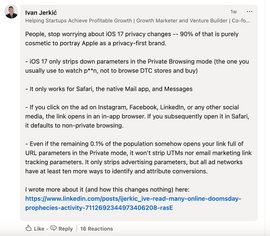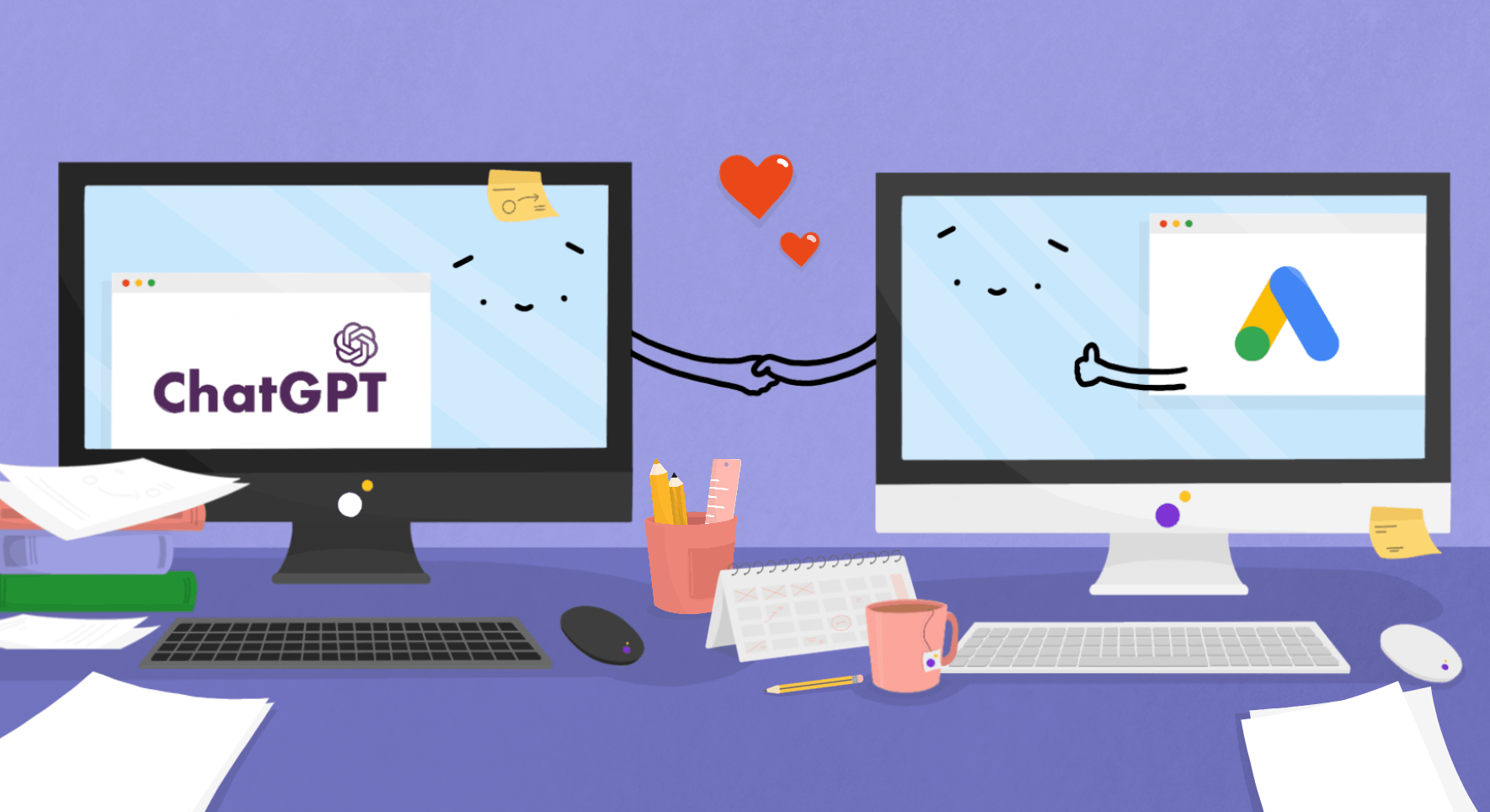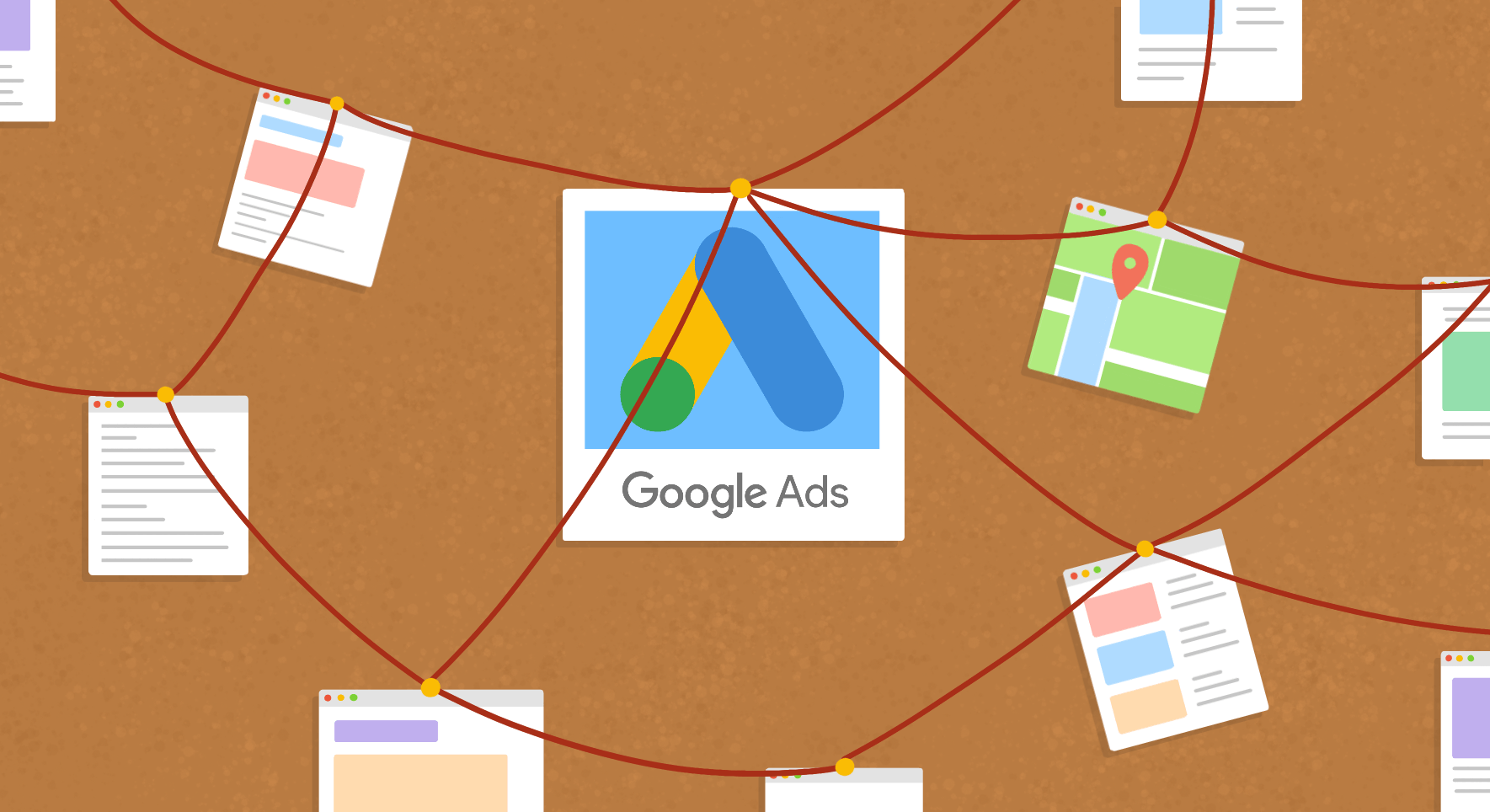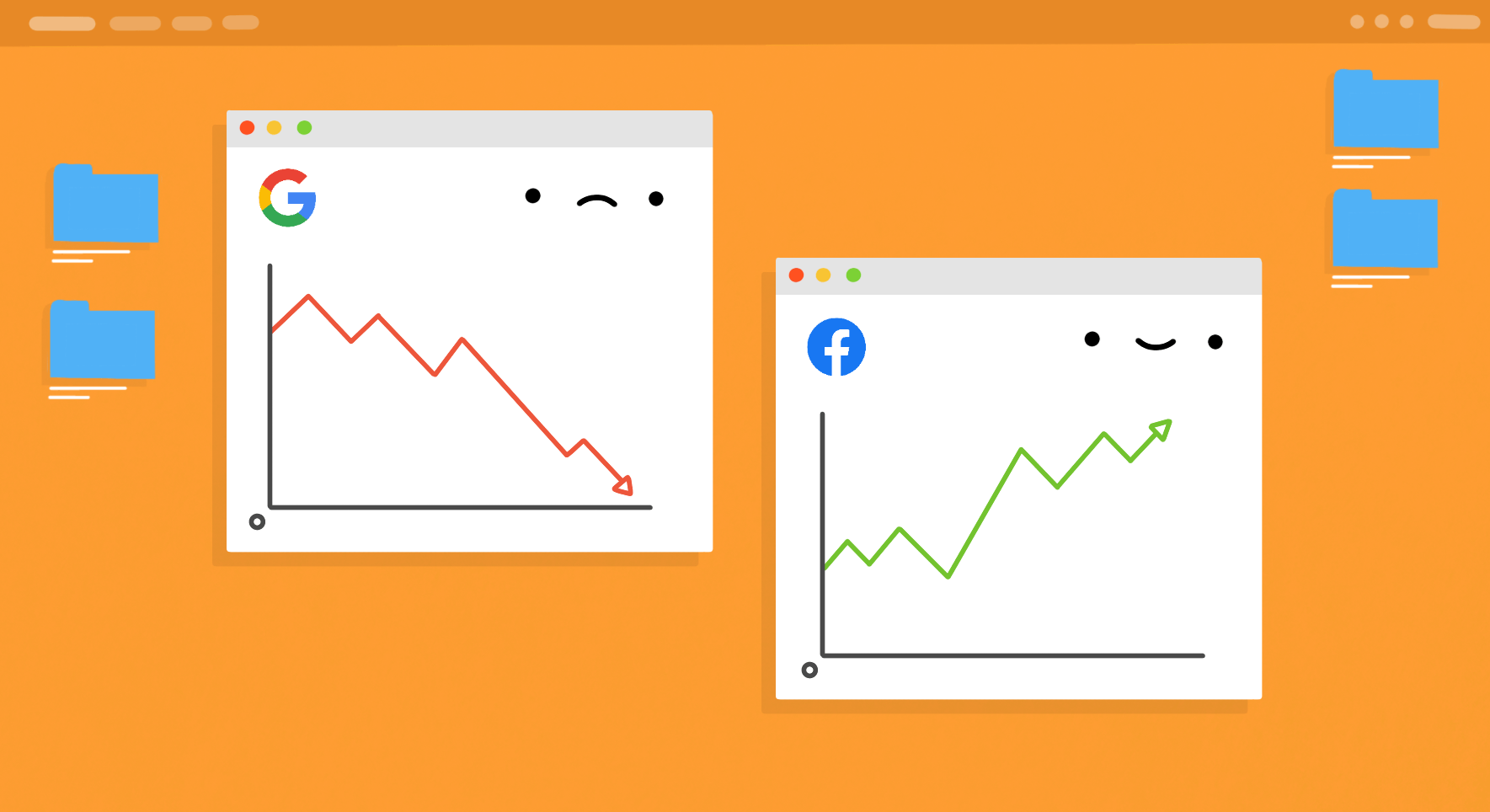User privacy is a big topic in tech right now. As more people become aware of the risks of sharing their personal information online, tech companies are responding to these concerns by rolling back certain tracking measures. That’s why Apple has released Link Tracking Protection (LTP) as part of its iOS 17 update.
Apple’s last major privacy update came in 2021. The iOS 14.5 app tracking update gave users more control over whether apps were allowed to track their activity, which had a huge impact on marketers at the time.
Link Tracking Protection probably won’t have such a seismic impact on advertisers. But with more than 50% of all UK device users operating on iOS, it will probably affect you to some degree. LTP is likely to make attribution more difficult, and has other implications for advertisers too. So all performance marketers should be aware of how this iOS 17 link tracking release will affect their ads.
What is iOS 17 Link Tracking Protection?
iOS 17 Link Tracking Protection essentially removes the parameters that allow advertisers and affiliates to track user activity after the click. As Apple explained in their release notes:
“Some websites add extra information to their URLs in order to track users across other websites. Now this information will be removed from the links users share in Messages and Mail, and the links will still work as expected. This information will also be removed from links in Safari Private Browsing.”
Apple also provided an example of how URLs might look before and after LTP is applied:
Eliminate Fake Traffic From Paid Campaigns
Ads are for humans, not bots. Get a demo and save up to 25% of your advertising budget by automatically eliminating fake ad engagements across all paid channels.
Which Tracking Parameters Will Be Removed?
Here are all the tracking parameters iOS 17 Link Tracking Protection will remove and retain:
| Tracking Parameters Removed | Tracking Parameters Retained |
| gclid — Google Ads/Analytics | UTMs — Urchin Tracking Modules |
| dclid — Google Display Network | pk_* — Piwik/Matomo |
| fbclid — Facebook/Meta Ads | piwik_* — Piwik/Matomo |
| twclkd — Twitter/X Ads | mtm_* — Matomo |
| msclkid — Microsoft Advertising | hsa_* — Hubspot |
| mc_eid — Mailchimp | epik — Pinterest |
| igshid — Instagram Ads | ef_id — Adobe Advertising Cloud |
| s_kwicid — Adobe Analytics | |
| dm_i — Dotdigital | |
| _branch_match_id — Branch | |
| mkevt — eBay | |
| campid — eBuy | |
| si — Spotify | |
| _bta_tid — Bronto | |
| _bta_c — Bronto | |
| _kx — Klaviyo | |
| tt — TikTok | |
| ir — Impact Radius | |
| elevar_test — Arbitrary ID |
As you can see, Apple is actually keeping more tracking parameters than it removes. But parameters for many of the most popular ad networks — including Google — have been removed, which could impact how you track clicks and other user activity on your best-performing platforms.
For Google, at least, there may be an alternative. Frederik Boysen, CEO of Profitmetrics.io, says:
Google has two other click IDs: Gbraid and Wbraid. These are similar parameters passed in the URL with ad clicks, but they comply with Apple’s ATT framework and ensure Google its ability to track.
Switching from gclid to gbraid or wbraid may enable you to keep your Google tracking links in place, at least for the time being.
What Are Marketers Saying?
While removing link tracking sounds worrying, not all marketers are concerned about the developments:
Vlad Zhovtenko, CEO of RedTrack.io, agrees with this opinion:
“There is not much to worry about unless you do heavy volumes of traffic from Messages, Mail, and Safari Private Browsing.”
Users clicking through from Mail, Messages, and Safari Private Browsing account for a very small proportion of traffic for most businesses. And even if you are affected, there are alternative ways to set up your tracking to ensure you get an accurate picture of user activity.
However, other marketers are concerned that this iOS 17 Link Tracking Protection update signals the start of more significant changes to user tracking:
As we’ve already seen, Apple seems keen to prioritise user privacy over advertiser concerns. So there’s a chance they will remove tracking in non-private Safari browsing modes, and/or tighten restrictions on other URL parameters in future. So it’s important to futureproof your tracking techniques ahead of time.
How Does This Impact Attribution?
Tracking parameters help marketers understand the success of their individual campaigns. This helps you invest more in platforms that work well for you while withdrawing from less successful networks, so you can get the best possible return on ad spend.
By removing certain parameters from your URLs, Apple effectively reduces your ability to track campaign success on individual platforms. While UTM parameters remain in place — allowing you to get an overall picture of a campaign’s performance — specific parameters for many of the most popular platforms will be removed.
Nik and Moiz at Limited Supply predict this will have a particularly big impact on eCommerce brands:
“If you’re an apparel company with 100 products, every flow would have to have different SKUs and PDPs [product detail pages]. It would get so unwieldy so fast. I think even brands that think they’re not discount brands are going to have to start using coupon codes for attribution.”
There are tracking alternatives, so it may not come to this. For example, Apple has enabled an alternative attribution tool known as Private Click Measurement. This is a type of privacy-compliant ad attribution that allows advertisers to track conversion events.
But Private Click Measurement doesn’t give you the rich attribution data you need to create effective Lookalike Audiences, retargeting campaigns, and affiliate marketing schemes. So even if brands aren’t forced into using discount codes for attribution purposes, they may need to make significant changes to how they reach and convert customers.
Other Implications of Link Tracking Protection For Marketers
The introduction of Link Tracking Protection may pose other problems for marketers. These include:
- Reduced personalisation — Removing individual user tracking will make it harder for marketers to offer a personalised experience to their buyers, which could have a negative impact on the user’s shopping experience.
- Difficulty segmenting audiences — Audience segmentation ensures users see information that’s valuable to them. This may be compromised if advertisers can’t segment audiences based on unique user activity.
- Retargeting challenges — User-specific tracking parameters are often used to retarget past website visitors. Without these, you can’t always capitalise on your previous advertising efforts and reach engaged audiences.
- Inaccurate reporting — Without user tracking, it becomes harder to get the right data to support your decisions. This can lead to leaky ad budgets and reduced click-through and conversion rates.
Alternative Link Tracking Solutions
If you haven’t already, you may need to adjust the way you track user activity for iOS users. Here are five of the best alternative link tracking solutions you can implement now:
1. UTM Tracking
UTM tagging hasn’t (yet) been removed by Apple. So you can still use it to track campaign results using a last-click attribution model.
UTM tags are easy to add to your campaigns, so you can replace any legacy parameters with UTMs. You may be able to use UTM auto-tagging on some platforms, but others will need to be updated manually.
Relying solely on UTM data can help with attribution, but it’s a good idea to combine it with other methods. Digital Strategist Emil Mrsic explains:
All UTM data is basically last-click information. It’s the last time somebody clicked your ad, and this is important to know because we want to pass on as much of that information as we can. But when it fails, we don’t want to be left an alert wondering what we missed.
2. Switch to First-Party Data
As third-party cookies are phased out, advertisers are encouraged to collect and use their own first-party data. This can increase direct engagement with users, so you can continue to segment your audiences and personalise your content for individuals. In fact, first-party data is the key to hypersegmentation in marketing.
Examples of first-party data capture include:
- Filling out forms on your website.
- Completing a purchase through your eCommerce shop.
- Capturing user information in your CRM.
If you don’t already collect first-party data, it may take a little while to build up enough information to inform new campaigns. But user privacy constraints are only going to get tougher, so it’s never too late to start.
3. Use Privacy-Safe Attribution Tools
Many tech companies have stepped up their security measures recently. But ad revenue is essential for ad networks like Google and Meta, so they’ve introduced their own privacy-safe tools that allow advertisers to continue to get reliable data from their platforms.
Making use of tools like Meta’s Aggregated Event Measurement and Apple’s Private Click Measurement can give you useful data, while remaining compliant with privacy measures like LTP.
4. Contextual User Targeting
Connect with top-of-funnel users with contextual user targeting. Contextual advertising helps boost brand awareness without compromising user privacy.
Placing your ads on sites and networks that are regularly visited by your target audience makes them more likely to see and engage with your ads. See how Ryan Reynolds makes it work:
5. Leveraging Customer Surveys
Use surveys to glean information from customers that can inform managed ad placements, help you understand messaging effectiveness, and give you updated first-party data.
You can also use surveys to confirm attribution. Matt Bahr, CEO of Fairing, explains:
Compared to last-click UTM parameters, responses show you how random paths of purchase are. A lot of it is Google CPC and all these things that drive the last click in the lower-funnel conversion. But then someone will say, “My mum told me about the brand”. That’s what we get most excited about; starting with the “How did you hear about us?” question, and then on the attribution side, maybe adding “When did you first hear about us?”
Get Full Transparency Over Your Paid Media Clicks
iOS 17 may cause you to lose some marketing data. And the push towards greater levels of automation means advertisers are continuing to lose other insights and transparency over campaign performance – as more networks are rolling out “black box” automated solutions.
Lunio gives you access to data ad platforms don’t show – namely, the validity of every single click on your paid ads. By detecting invalid traffic and automatically excluding it from your campaigns you can focus your spend on genuine prospects and maximise your ROAS.
Our Wasted Ad Spend Report 2024 forecasts businesses will lose $204.83bn in revenue opportunities due to invalid traffic in 2024. Protecting your ad budget with Lunio maximises your performance marketing efficiency and ensures you’re making campaign optimisation decisions with accurate and reliable click data.
Eliminate Fake Traffic From Paid Campaigns
Ads are for humans, not bots. Get a demo and save up to 25% of your advertising budget by automatically eliminating fake ad engagements across all paid channels.











